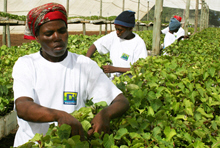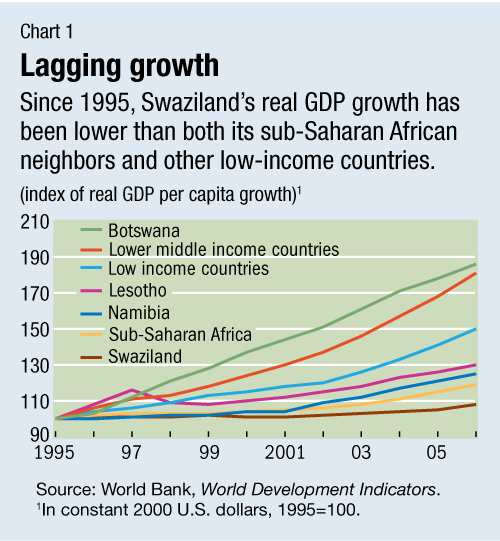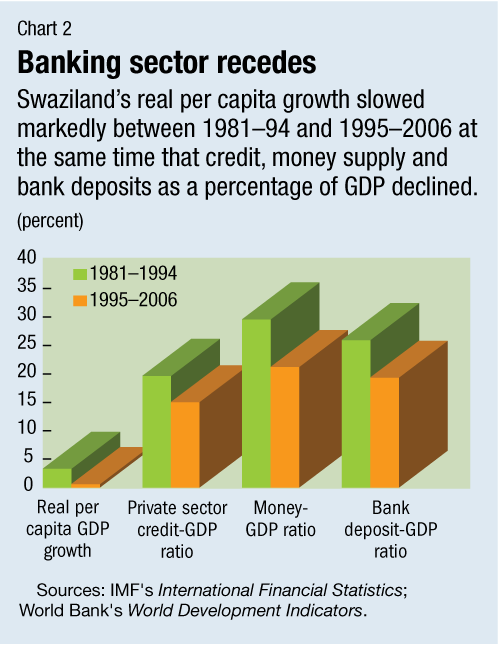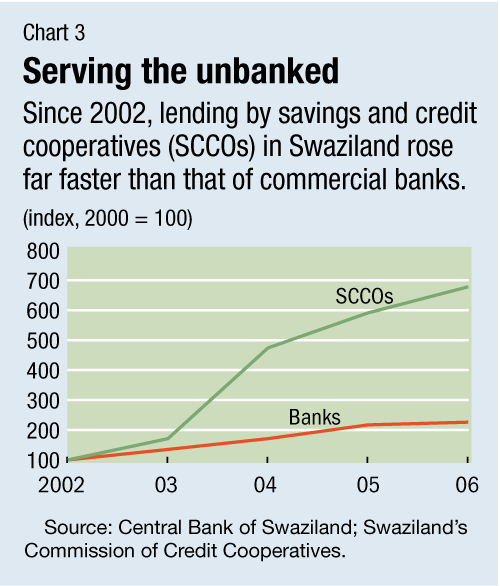
Typical street scene in Santa Ana, El Salvador. (Photo: iStock)
IMF Survey: Swaziland's Economy Stagnates; Financial Reforms Needed
July 28, 2008
- Slow growth may have worsened already difficult conditions
- Role of banking sector in economy has declined
- Steps needed to enhance growth, strengthen financial sector
When the rest of sub-Saharan Africa was growing over the last decade, the economy of the Kingdom of Swaziland stagnated.

Workers tend jatropha plants in Hluthi, Swaziland, where export growth prospects are limited by rising competition (photo: Isaac Mangena/AFP)
SUB-SAHARAN AFRICA
The slow growth may have worsened already difficult conditions in the tiny, landlocked country where in 2001, the latest year for which there are data, about two-thirds of its 1 million residents lived in poverty and 20 percent of the population claimed two-thirds of the income. A major contributor to the stagnating Swazi economy has been its financial sector, which, while in the main healthy, has taken steps backward in the past decade.
Swaziland's real per capita GDP growth declined from an annual rate of 2 ½ percent during 1980-94 to 0.7 percent since then (see Chart 1). In contrast, real growth in all of sub-Saharan Africa has averaged 1 ½ percent annually since 1995 and in other lower-middle-income countries, growth averaged 7 ½ percent.

Shallower banking system
Some studies suggest that the deeper the financial system—that is, the more access businesses and individuals have to varied financial services—the better equipped it is to mobilize resources and the more important is its effect on growth, poverty reduction, and income equality.
But instead of deepening, or increasing its role in the economy, Swaziland's banking system has, by almost any measure, become shallower. Private sector lending, money supply, and bank deposits as a percentage of GDP have all declined since 1995 (see chart 2) while high poverty and income inequality persist in a country that also has the highest incidence of HIV/AIDS in the world.

Financial, real economies linked
There are a number of important linkages between the real economy and the financial sector in Swaziland that explain, at least in part, the country's performance:
The country mobilizes too little domestic saving (8 percent of GDP) to finance investment, and foreign savings have fallen off since the 1980s and 1990s. Annual investment rates have declined from 25 percent of GDP for the period 1981-94 to 19 percent since then—far below other low-income and lower-middle-income countries in the region.
• High government spending, well beyond current revenues, has produced a large civil service wage bill that, together with poor selection and appraisal of public investment projects, has hurt growth.
• Access to finance is limited, which constrains financing of growth-enhancing investment projects. The commercial banking system has concentrated on export financing and bypassed a large portion of the adult population. The World Bank estimates that only 35 percent of the Swazi adult population has access to a bank account—too low, given its stage of development . There is no public credit registry, and private credit bureaus cover only 38 percent of the population.
• Despite the sizable loans it receives from banks, the export sector has not been an effective engine of growth and employment. Swaziland's main exports are soft-drink concentrates, sugar, textiles, and pulp paper. But growth prospects for those exports are limited because of intense competition from other countries and gradual erosion of preferential arrangements with trading partners such as the United States and the European Union, as well as adverse movements in Swaziland's real exchange rate.
• Swaziland has a weak investment climate, which tends to push up the cost of capital and the rate of return investors seek. With few viable real investment opportunities in Swaziland, most private domestic savings—in particular from pension funds and insurance companies—are invested in South Africa's deeper financial markets, which offer a wider array of financial services to a broader spectrum of investors. In response, Swazi authorities have required pension and insurance companies to gradually return a portion of those investments to the domestic market.
• The financial sector has become more vulnerable as a result of inadequate regulation and supervision of nonbank financial institutions (NBFIs), especially the savings and credit cooperatives (SCCOs) that have sprung up to fill the financial needs of the many Swazis abandoned by the commercial banking sector. Since 2002, lending by SCCOs has grown 116 percent, compared with 26 percent for banks (see Chart 3). Among the NBFIs, pension funds and insurance companies are generally sound, but some SCCOs face severe financial difficulties that could undermine confidence in the financial sector and limit SCCOs' recent gains in access to finance.

• The depth of financial markets is further limited by lack of access to collateral for many borrowers. About 60 percent of the land is held in public trust and cannot be used by farmers, for example, to secure loans to invest in increasing agricultural yields. As a result, most of the people who live on these public lands are limited to accumulating savings in traditional assets such as livestock. With no incentives, or ability, to access the formal financial sector they have to rely on subsistence agriculture. The limited prospects for scaling up agricultural yield and growth are a blow to a country in which most people live in rural areas.
What is to be done?
If Swaziland is improve its growth performance, mobilize savings, and diversify and strengthen its export sector, there are a number of steps it should consider.
First, it should identify what constraints most hinder its growth and in the process assess the effects of continued dependence on temporary preferential trade treatments for exports. This type of analysis, called growth diagnostics, should also enable Swaziland to learn from the success of small countries like it that have enjoyed sustained growth, such as Mauritius.
Second, it should take steps to mobilize domestic savings to finance investment that would be permanent and durable, perhaps diversifying the Swazi economy into sectors such as mining and tourism. The recent decision to channel pension fund and insurance company savings from abroad to the domestic market is one source of those savings, although authorities should ensure that investors are not exposed to risk of low or negative returns.
Public-private partnerships
Swaziland might consider joint ventures between the government and private enterprise, commonly called public-private partnerships (PPPs), which have the potential to harness the savings for viable investment projects while being guided by a growth diagnostic study.
Third, in a related effort, Swaziland should improve the investment climate. The government has set up a one-stop shop to help private foreign investors deal with administrative barriers. But, as many other countries have discovered, one-stop shops in and of themselves are not enough to attract foreign investors.
Swaziland must also reduce labor market rigidities, simplify business licensing, enforce contracts, widen the coverage of credit bureaus, and grant ownership rights to lands held in public trust. As a landlocked country—bordered by South Africa on three sides and by Mozambique—it should also reduce the cost of trade that crosses its borders.
Fourth, it should enhance regulation and supervision of NBFIs. Welcome steps have been taken since 2006 for pension and insurance companies. Stepped-up efforts are needed, however, for the other NBFIs—especially the SCCOs—to put them on a sounder basis.
Finally, Swaziland should scale back government. Reducing the excessive wage bill, subsidies, transfers, and unproductive investment can over time create room to allow the government to fight HIV/AIDS and allow the emergence of a private debt market to promote investment. Viability of state development financial institutions should be reviewed further with an eye toward their possible privatization, and be linked to well-designed PPPs to make the maximum contribution to growth.
Comments on this article should be sent to imfsurvey@imf.org







